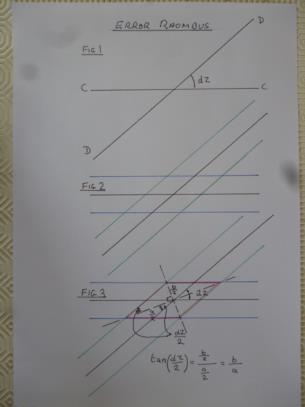
NavList:
A Community Devoted to the Preservation and Practice of Celestial Navigation and Other Methods of Traditional Wayfinding
From: David Pike
Date: 2017 Jun 11, 03:59 -0700
My philosophy is if I can draw it I ought to be able to understand it, so how about this for a mainly non-mathematical approach.
Fig1. Let CC and DD be the median lines of observations on stars C and D
Fig2. Then x% of the observations on star C will fall inside the blue lines and x% of the observations on D will fall inside the green lines.
Fig3. Therefore, being careful not to commit myself to stating a percentage of observations, the area common to the space between the green and the blue lines is the red rhombus, and the ratio of the minor and major diagonals of that rhombus b/a = tan(dz/2).
But surely, the rule of thumb should be, for a two star fix, pick bright stars as close to 90 degrees apart as possible and never less than 30 degrees apart. Also, don’t ignore your DR position completely. You’ve spent the last several hours, days, weeks, working on it. It ought to have an influence on your choice of most probable position. DaveP







